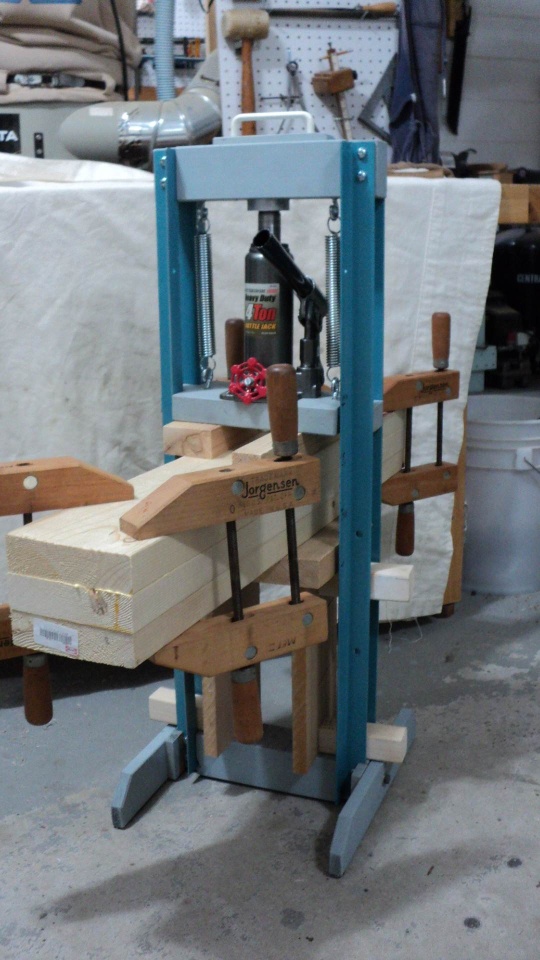I decided to make a small scale shop press since on several occasions I had a need for one while doing projects. My design criteria was based on the lowest cost to achieve a quality product, and so that called for creative thinking as to materials and maximum tonnage one would need to impose. The most expensive item was the purchase of a 4- ton hydraulic bottle jack, this being about $15, and I mounted it in the usual way as found in higher tonnage units. The rest of the build materials were roadside gifts such as a bed frame's angle, and scrap hardwood (pallet hardwood, even glue- ups). A composite of steel and wood can yield a very serviceable bit of equipment, and for assembly conventional fasteners were used instead of weldments, in fact nothing is welded, and one can build this project using the most modest of tools.
Some additional information:
Springs were needed that would retract the ram without overkill on the return force, I found a pair of 7/8" dia. x 6" L. X .091 wire worked just fine from H.D.
Mounted to the Waist Plate is a 3/8" NPT Floor Flange and 2" nipple which serves as a ram & tool attachment system.
The height was simply the length of bedrails cut in two, your dimensions will vary depending on needs and materials, thus customization may allow under workbench storage if needed.
Running a round file inside to remove the weld and hacksawing an "X" down the threads makes this tapered fitting a collet, thus one can make unlimited special adaptors based on need. For starters I just modified a 1/2" capscrew to use as a general purpose nose.
Tighten the fitting's flats and the nose tool is held fast yet can quickly be swapped out for other tools.
The Waist Plate rides up and down the column angles with about 1/16" clearance all around, this helps direct the force precisely where needed.
The base of most bottle jacks are rough cast, and need a little filing or sanding to fair and flatten them so that force is evenly distributed across the Waist Plate.
Although I turned a Socket Plate for the jack's ram, a ferrule or other device can be used to house that part. The object is to safely restrain the jack yet allow it to do it's job. The final step was to make sure the jack was centered, then drill and mount screws through the base.
I next loaded the press to maximum pressure, checked for square, and retightened all fasteners. Deflection of the Head Rail was barely perceptible across the top during this operation.

First use of my new shop tool is to assist in the removal and replacement of a motor's bearing set, an outstanding success story that is documented here.
Adjustable Flank Supports are simply set to a scale scribed on the Foot Rail to ensure even, parallel force application.
A used cabinet door pull makes a nifty carrying handle, and a little filing and tapping permitted me to mount an old valve wheel handle to bleed the cylinder off without using a tool.

Here it is used to help construct a 32" long glueup that will be resawn into cabinet legs. The major amount of force is imparted to the middle with handscrews taking care of the ends. Can also be used for small flat panel veneering jobs of appropriate size.
A short list of other possible uses for a shop press are:
PRESS BRAKE
CUTOFF SHEAR
NOTCHER
HONEYCOMB PRESS
CLICKER DIE
HOLE PUNCHING
WIRE ROD BENDING
RIVET AND GROMMET SETTER
METAL FORMING
The design of course depends on desired end results, but not having a shop press is now unthinkable in my workshop.
It should be noted that in most instances the precision use of force will be more influential than the bone- crushing type, which is why I made sure the frame and it's parts were all very square in relation to each other. With even a modicum of care in machining and assembly, perfect results can be expected.
This Web Page Created with PageBreeze
Free HTML Editor